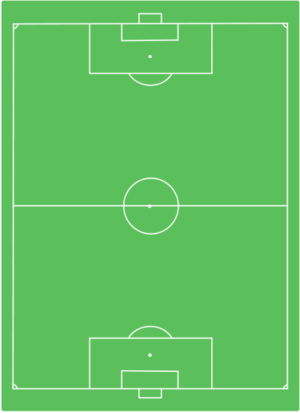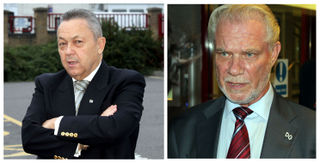West Ham United F.C.
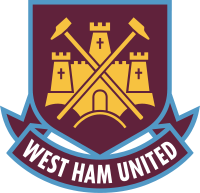 |
|||
| Full name | West Ham United Football Club | ||
|---|---|---|---|
| Nickname(s) | The Hammers The Irons The Academy of Football |
||
| Founded | 1895 as Thames Ironworks | ||
| Ground | Boleyn Ground (Upton Park) (Capacity: 35,303[1]) |
||
| Owner | David Sullivan 30.6% David Gold 30.6% CB Holding Ltd. 35% Minority Investors 3.8%[2] |
||
| Manager | Avram Grant | ||
| League | Premier League | ||
| 2009–10 | Premier League, 17th | ||
|
|||
West Ham United Football Club is an association football club based in Upton Park, Newham, East London. The club have played home matches at the Boleyn Ground stadium since 1904. The club was founded in 1895 as Thames Ironworks FC and reformed in 1900 as West Ham United. They initially competed in the Southern League and Western League before eventually joining the full Football League in 1919 and subsequently enjoyed promotion to the top flight for the 1923 season. 1923 also saw the club feature in the first FA Cup Final to be held at Wembley against Bolton Wanderers. West Ham currently compete in the Premier League, and finished in 17th position in the 2009–10 season. They have been members of the Premier League for all but three seasons since its creation in 1992, and their highest finish in the Premier League was fifth in the 1998–99 season. The team's current manager is Avram Grant, who has a 4-year contract.[3] He replaced Gianfranco Zola in June 2010 due to his dismissal.
In 1940 the team won the inaugural Football League War Cup. Subsequently the club have won the FA Cup three times: in 1964, 1975 and 1980 as well as being runners-up twice, in 1923 and 2006. In 1965, they won the European Cup Winners Cup, and in 1999 they won the Intertoto Cup. The club's best final league position is third place in the 1985–86 (old) First Division.
Three West Ham players were considered an important factor behind England's triumph in the 1966 World Cup, as England's captain at the time was West Ham's Bobby Moore, and both goalscorers in the final were Hammers players Geoff Hurst and Martin Peters. Bobby Moore also assisted the first and fourth goals. Geoff Hurst claimed the man of the match.
Contents |
History
Origins
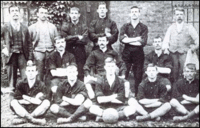
The earliest generally accepted incarnation of West Ham United was founded in 1895 as the Thames Ironworks team by foreman and local league referee Dave Taylor and owner Arnold Hills[4] and was announced in the Thames Ironworks Gazette of June 1895.
The team played on a strictly amateur basis for 1895 at least, with a team featuring a number of works employees including Thomas Freeman (ships fireman), Walter Parks (clerk), Tom Mundy, Walter Tranter and James Lindsay (all boilermakers), William Chapman, George Sage, and William Chamberlain and apprentice riveter Charlie Dove.[4]
|
The club, Thames Ironworks[6] were the first ever winners of the West Ham Charity Cup in 1895 contested by clubs in the locality, then won the London League in 1897. They turned professional in 1898 upon entering the Southern League Second Division, and were promoted to the First Division at the first attempt.[7] The following year they came second from bottom, but had established themselves as a fully fledged competitive team. They comfortably fended off the challenge of local rivals Fulham in a relegation play-off, 5–1 in late April 1900 and retained their First Division status.[7]
The team initially played in full dark blue kits, as inspired by Mr. Hills, who had been an Oxford University "Blue", but changed the following season by adopting the sky blue shirts and white shorts combination worn through 1897 to 1899. In 1899 they acquired their now traditional home kit combination of claret shirts and sky blue sleeves in a wager involving Aston Villa players, who were League Champions at the time.
Following growing disputes over the running and financing of the club in June 1900 Thames Ironworks F.C. was disbanded,[6] then almost immediately relaunched on 5 July 1900 as West Ham United F.C. with Syd King[6] as their manager and future manager Charlie Paynter as his assistant. Because of the original "works team" roots and links (still represented upon the club badge), they are still known to this day as 'the Irons' or 'the Hammers' amongst fans and the media.[6][8][9]
Birth of West Ham United
The reborn club continued to play their games at the Memorial Ground in Plaistow (funded by Arnold Hills) but moved to a pitch in the Upton Park area when the team officially severed ties with the company (losing their works provisioned offices in the process). After being made groundless in 1901 the team became transient, playing their home games on a number of local teams' grounds until moving to its current home, Upton Park (in the guise of the Boleyn Ground stadium), in 1904.
West Ham's first game in their new home was against fierce rivals Millwall[6] (themselves an Ironworks team, albeit for a rival company) drawing a crowd of 10,000 and with West Ham running out 3–0 winners,[10] and as the Daily Mirror wrote on 2 September 1904:
| “ | "Favoured by the weather turning fine after heavy rains of the morning, West Ham United began their season most auspiciously yesterday evening; when they beat Millwall by 3 goals to 0 on their new enclosure at Upton Park." | ” |
West Ham Utd had joined the Western League for the 1901 season[11] in addition to continuing playing in the Southern Division 1. In 1907 West Ham were crowned the Western League Division 1B Champions, and then defeated 1A champions Fulham 1–0 to become the Western Leagues Overall Champions.[11]
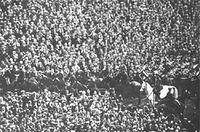
In 1919, still under King's leadership, West Ham gained entrance to the Football League Second Division, the first game being a 1–1 draw with Lincoln City, and were promoted to Division One in 1923, also making the first ever FA Cup Final to be held at the old Wembley stadium. Their opponents were Bolton Wanderers. This was also known as the White Horse Final. This is because so many people turned up to the game, (estimated at 200,000), that they spilled out on to the pitch. The pitch had to be cleared prior to kick-off, by Billie, a giant white horse (actually grey) being ridden by PC George Scorey. The Cup Final match itself ended 2–0 to Bolton Wanderers. The team enjoyed mixed success in Division 1 but retained their status for 10 years and reached the FA Cup semi-final in 1927.
In 1932 the club was relegated to Division Two and long term custodian Syd King was sacked after serving the club in the role of Manager for 32 years, and as a player from 1899 to 1903. He was replaced with his assistant manager Charlie Paynter who himself had been with West Ham in a number of roles since 1897 and who went on to serve the team in this role until 1950 for a total of 480 games.
The club spent most of the next 30 years in this division, first under Paynter and then later under the leadership of former player Ted Fenton. Fenton succeeded in getting the club once again promoted to the top level of English football in 1958 and in helping develop both the initial batch of future West Ham stars and West Ham's approach to the game.
The Glory Years
Ron Greenwood was appointed as Fenton's successor in 1961 and he soon led the club to two major trophies, winning the FA Cup in 1964 and the European Cup Winners' Cup in 1965.
During the 1966 World Cup, key members of the tournament winners England were West Ham players, including the captain, Bobby Moore; Martin Peters (who scored in the final); and Geoff Hurst, who scored the only hat-trick (to date) in a World Cup final.
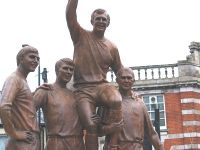
There is a "Champions" statue in Barking Road, opposite The Boleyn pub, commemorating West Ham's three sons who helped win the 1966 World Cup: Bobby Moore, Geoff Hurst and Martin Peters. Also included on the statue is Everton's Ray Wilson.
After a difficult start to the 1974–75 season, Greenwood moved himself "upstairs" to become General Manager and without informing the board, appointed his assistant John Lyall as team manager. The result was instant success – the team scored 20 goals in the their first four games combined and won the FA Cup, becoming the last team to win the FA Cup with an all English side when they beat Fulham 2–0 in the 1975 final.
Lyall then guided West Ham to another European Cup Winners' Cup final in 1976, though the team lost the match 4–2 to Anderlecht. Greenwood's tenure as General Manager lasted less than three years, as he was appointed to manage England in the wake of Don Revie's resignation in 1977.
Ups and Downs
In 1978, West Ham were again relegated to Division Two, but Lyall was retained as manager and led the team to an FA Cup Final win against Arsenal in 1980. This is notable because no team outside the top division has won the trophy since that time. West Ham were promoted to Division One in 1981, and finished in the top ten of the first division for the next three seasons, before achieving their highest ever league finish of third in 1985/86. However, they were relegated again in 1989. This second relegation resulted in John Lyall's sacking, despite the fact that that stay in Division One saw West Ham achieve their highest-ever placing in the top division, finishing 3rd in 1986.
After Lyall, Lou Macari briefly led the team, though he resigned after less than a single season in order to clear his name of allegations of illegal betting whilst manager of Swindon Town. He was replaced by former player Billy Bonds. In Bonds' first full season (1990–91), West Ham again secured promotion to Division One. The following season they were again relegated to Division 2, which had been renamed Division One as part of the league realignments surrounding the creation of the English Premier League in 1992. West Ham spent the 1992–93 season in Division One. finishing second and returning to the Premier League in May 1993.
After the 1993–94 season, Bonds quit and was replaced by Harry Redknapp in August 1994. He led West Ham to fifth place in the 1998–99 season, but missed automatic qualification for the UEFA Cup, and instead qualified as winners of the Intertoto Cup. Despite consolidating the league placings for a handful of seasons, a disagreement with the board of directors during the close of the 2000–01 season led to Redknapp being replaced by Glenn Roeder, promoted from youth team coach.
In Roeder's first season the team finished seventh, but West Ham lost by wide margins in several matches (7–1 to Blackburn, 5–0 to Everton and 5–1 to Chelsea) The subsequent season started badly and eventually resulted in relegation. Roeder, who had missed some of the season after being diagnosed with a brain tumour that was treated) was sacked on 24 August 2003, three games into the Championship campaign.
Trevor Brooking (who served as manager during Glenn's ill health the previous season) stepped in as interim manager before being replaced by Alan Pardew in October 2003, headhunted from fellow promotion contenders Reading. Pardew led the team to a playoff final, though they were beaten by Crystal Palace. The club stayed in Division One (which at this time became the Championship) for another season, when they again reached the playoff final, but this time won, beating Preston North End 1–0, gaining re-entry to the Premier League.
Recent seasons
On their return to the top division, West Ham finished in 9th place,[12] The highlight of the 2005–06 season, however, was reaching the FA Cup final, and taking favourites Liverpool to a penalty shootout, after a thrilling three-all draw. Although West Ham lost the shootout, they gained entry to the UEFA Cup as Liverpool had already qualified for the Champions League through league position.
In August 2006, West Ham completed a major coup on the last day of the transfer window, after completing the signings of Carlos Tévez and Javier Mascherano.[13] The club was eventually bought by an Icelandic consortium, led by Eggert Magnússon in November 2006.[14] Manager Alan Pardew was sacked after poor form during the season[15] and was replaced by former Charlton manager Alan Curbishley.[16]
The signings of Mascherano and Tévez were investigated by the Premier League, who were concerned that details of the transfers had been omitted from official records. The club was found guilty and fined 5.5 million pounds in April 2007.[17] However, West Ham avoided a points deduction which ultimately became critical in their avoidance of relegation at the end of the 2006–07 season. Following on from this event, Wigan Athletic chairman Dave Whelan, supported by other sides facing possible relegation, including Fulham and Sheffield United, threatened legal action.[18]
West Ham escaped relegation by winning seven of their last nine games, including a 1–0 win over Arsenal, and on the last day of the season defeated newly crowned League Champions Manchester United 1–0 with a goal by Tévez to finish 15th, above the relegation zone. Tévez' contributions were arguably important to the survival of the club in the Premier League as he scored seven goals, five of them crucial, in the last couple of months of the season to enable the team to stay up, notwithstanding his ineffectiveness throughout the early part of the season.
In the 2007–08 season, West Ham had a reasonably consistent place in the top half of the league table despite a slew of injuries; new signings Craig Bellamy and Kieron Dyer missed most of the campaign. The last game of the season, at the Boleyn Ground, saw West Ham draw 2–2 against Aston Villa; ensuring 10th place, finishing three points ahead of rivals Tottenham Hotspur. It was a five-place improvement on the previous season, and most importantly West Ham were never under any realistic threat of relegation.
After a row with the board over the sale of defenders Anton Ferdinand and George McCartney to Sunderland, manager Alan Curbishley resigned on 3 September 2008. His successor, the former Chelsea striker Gianfranco Zola took over on 11 September 2008 and in so doing became the club's first foreign manager (The Scottish manager Lou Macari was the only other manager not from England), to coach the club and became West Ham's 12th manager.[19]
In the 2008–09 season, under Zola's stewardship West Ham finished 9th, this season one place behind their rivals Tottenham Hotspur. Zola's team had an impressive second half of the season just missing out on European qualification after being one point above the relegation zone on Christmas Day.
In the 2009–10 season, West Ham started strongly with a 2–0 win over newly promoted Wolves with goals from Mark Noble and newly appointed captain Matthew Upson. However the victory was soon overshadowed as the club were once again in the media spotlight for the wrong reasons. A League Cup match against old rivals Millwall brought about violent riots outside the ground as well as pitch invasions and crowd trouble inside Upton Park.[20][21]
In August 2009 finanicial worries continued at the club with the current owners unable to provide any funds until a new owner was found. The club's shirt sponsor, SBOBET, provided the club with support to help purchase a much needed a striker, Alessandro Diamanti, as, at the time, the club had only one, fit, experienced striker available.[22]
West Ham had a poor season which saw them in a relegation battle for most of it. They secured their survival after beating Wigan 3–2, with two games left and other results going their way. They only managed to take 35 points out of 38 games, 7 less than when they last got relegated. On 11 May 2010, two days after the end of the 2009–10 season, West Ham announced the termination of Zola's contract with immediate effect.[23] On 3 June 2010, Avram Grant signed a four year deal to become the next manager of West Ham subject to a work permit.[24]
Crest
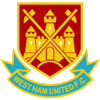
The original club crest was a crossed pair of rivet hammers; tools commonly used in the iron and shipbuilding industry. A castle was later (circa 1903/04) added to the crest and represents a prominent local building, Green Street House, which was known as "Boleyn Castle" through an association with Anne Boleyn. The manor was reportedly one of the sites at which Henry VIII courted his second queen, though in truth there is no factual evidence other than the tradition of rumour.[25]
The castle may have also been added as a result of the contribution made to the club by players of Old Castle Swifts, or even the adoption (in 1904) of Boleyn Castle FC[26] as their reserve side when they took over their grounds on the site.
The crest was redesigned and updated by London design agency Springett Associates in the late 1990s, featuring a wider yellow castle with fewer cruciform "windows" along with the peaked roofs being removed; the tops of the towers had previously made the castle appear more akin to Disneyland's Sleeping Beauty's Castle than a functioning fortress. The designer also altered other details to give a more substantial feel to the iconography.
When the club redesigned the facade of the stadium (construction finished 2001/02) the 'castle' from the later badge was incorporated into the structure at the main entrance to the ground. A pair of towers are now prominent features of the ground's appearance, both bearing the club's modern insignia (which is also located in the foyer and other strategic locations).
Colours
The original colours of the team were dark blue, due to Thames Ironworks chairman Arnold Hills being a former student of Oxford University. However the team used a variety of kits including the claret and sky blue house colours of Thames Ironworks, as well as sky blue or white uniforms.[27][28]
The Irons permanently adopted claret and blue for home colours in the summer of 1899. Thames Ironworks right-half Charlie Dove received the Aston Villa kit from his father William Dove, who was a professional sprinter of national repute, as well as being involved with the coaching at Thames Ironworks. Bill Dove had been at a fair in Birmingham, close to Villa Park, the home ground of Aston Villa and was challenged to a race against four Villa players, who wagered money that one of them would win.
Bill Dove defeated them and, when they were unable to pay the bet, one of the Villa players who was responsible for washing the team's kit offered a complete side's 'uniforms' to Dove in payment. The Aston Villa player subsequently reported to his club that the kit was 'missing'.
Thames Ironworks, and later West Ham United, retained the claret yoke/blue sleeves design, but also continued to use their previously favoured colours for their away kits, and indeed, in recent years the club have committed to a dark blue-white-sky blue rotation for the away colours.
Supporters, hooliganism and rivalries
Supporters
| “ |
I'm forever blowing bubbles, |
” |
|
—original lyrics to "Bubbles", from John Helliar[29] |
||
The team's supporters are famous for their rendition of the chorus of their team's anthem, "I'm Forever Blowing Bubbles" introduced to the club by former manager Charlie Paynter in the late 1920s. At the time, a Pears soap commercial featuring the curly haired child in the Millais "Bubbles" painting who resembled a player Billy J. "Bubbles" Murray in a local schoolboy team of Park School for whom the headmaster Cornelius Beal coined singing the tune "I'm Forever Blowing Bubbles" with amended lyrics.
Beal was a friend of Paynter, whilst Murray was a West Ham trialist and played football at schoolboy level with a number of West Ham players such as Jim Barrett. Through this contrivance of association the clubs fans took it upon themselves to begin singing the popular music hall tune before home games, sometimes reinforced by the presence of a house band requested to play the refrain by Charlie Paynter.[29]
There is a slight change to the lyrics sung by the Upton Park faithful. The second line's "nearly reach the sky" is changed to "they reach the sky", "Then like my dreams" is also changed to "And like my dreams". In addition the fans begin a chant of "United, United!" to cap it off.
| “ |
Bow Bells are ringing, for the Claret and Blue, |
” |
|
—Supporters song to the tune of 'The Bells are Ringing', circa 1960[30] |
||
The 1975 FA Cup version – which contains the original lyrics, and features vocals from the teams then current players – is always played before home games, with the home crowd joining in and carrying the song on after the music stops at the verse line "Fortune's always hiding". The song was originally released as a single by the 1975 Cup Final squad and has been covered on occasion by such as the Cockney Rejects.
Like other teams (such as Liverpool's adoption of "You'll Never Walk Alone") the team also have a history of adopting or adapting popular songs of the day to fit particular events, themes, players or personas. These have included serious renditions of theatre and movie classics such as "The Bells are Ringing", along with more pun laden or humorous efforts such as chanting former player Paolo di Canio's name to the canzone La donna è mobile by Verdi, or D.I. Canio to the tune of Ottawans D.I.S.C.O., or singing That's Zamora to the tune of Dean Martins 1953 classic That's Amore in honour of former Iron striker Bobby Zamora (this chant was originally created by the Brighton fans when he was at the club).
On the fans' darker side, they gained national attention after giving a torrid time to David Beckham in his first away match of 1998–99 the season after the England midfielder was sent off for a petulant foul on Diego Simeone.[31] Coinciding with the game there were claims (and an image taken) that fans, organised by a hardcore, had hung an effigy of the player outside a local pub. Although it was later revealed that the pub was in South-East London, the heartland of West Ham's greatest rivals Millwall. The West Ham fans did boo Beckham's every touch of the ball during the game, however.[32]
They have also displayed a particular zeal when it comes to abusing former players particularly those who are perceived to have abandoned the club, or performed some disservice. Famously Paul Ince ("Judas, Judas"[33]), Frank Lampard ("Fat Lumpolard"[34]), Jermain Defoe ("You're just a small Paul Ince"[35]), Craig Bellamy[36] and Nigel Reo-Coker[37] have born the brunt of verbal assaults and a guaranteed hostile reception at Upton Park. However, players such as Joe Cole, Michael Carrick, Rio Ferdinand, Bobby Zamora and Carlos Tévez receive applause and even standing ovations in honour of their contributions during their time at the club.
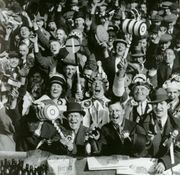
Many West Ham fans also follow Leyton Orient and Dagenham and Redbridge, West Ham fans can be seen at either Leyton Orient or Dagenham and Redbridge, whenever West Ham are playing away from home, although the warmth felt by West Ham fans for Orient is not usually reciprocated by the Orient supporters.
On 6 September 2009 the Daily Mirror newspaper carried a report that HM Queen Elizabeth II had admitted to being a long time West Ham supporter. She had overheard staff discussing football, one admitting to being a Millwall supporter.[38] Also, US President Barack Obama publicly stated during the 2008 election campaign that he is a West Ham supporter, and has been since his visit to England in 2003.[39]
Hooliganism
The origins of West Ham's links with organised football-related violence starts in the 1960s with the establishment of The Mile End Mob (named after a particularly tough area of the East End of London).[40]
During the 1970s and 1980s (the main era for organised football-related violence) West Ham gained further notoriety for the levels of hooliganism in their fan base and antagonistic behaviour towards both their own and rival fans, and the police. During the 70's in particular, Rival groups of West Ham Fans from neighbouring areas often did battle with each other at games, most often groups from the neighbouring districts of Barking & Dagenham.
The Inter City Firm were one of the first "casuals", so called because they avoided police supervision by not wearing football-related clothing and travelled to away matches on regular InterCity trains, rather than on the cheap and more tightly policed "football special" charter trains. The group were an infamous West Ham-aligned gang. As the firm's moniker "inter city" suggests violent activities were not confined to local derbies – the hooligans were content to cause trouble at any game, though nearby teams often bore the brunt.
There were often unofficial coach trips organized to away games and these coachloads often stopped off enroute at towns close to the motorways and did battle with local hooligans, and one particular such incident in Rugby on 5 November 1977, after a 0-1 defeat at Coventry has gone down in West Ham hooligan folklore.
During the 1990s, and to the present day, sophisticated surveillance and policing coupled with club supported promotions and community action has reduced the level of violence, though the intense rivalry and association with Millwall, Chelsea and other major players in the 'firm' scheme remains.
The 2005 film Green Street Hooligans (an allusion to the road on which the Boleyn Ground stands) depicted an American student played by Elijah Wood becoming involved with a fictional firm associated with West Ham, with an emphasis on the rivalry with Millwall. The two teams and their Chairmen moved to distance the clubs from the movie at the time. West Ham hooliganism was again highlighted in film in 2008, with the film based on the life of well known former hooligan Cass Pennant, Cass. Also a gang of armed robbers who supported West Ham were portrayed in the 2008 episode "Are We Not Men?" of the British sitcom The IT Crowd.
Rivalries
West Ham have strong rivalries with several other clubs. Most of these are with other London clubs, especially with their neighbours Tottenham Hotspur, Arsenal and also with Chelsea, which sublimates the age-old east versus west London rivalry. The rivalry between West Ham and Tottenham has been fuelled by players such as Martin Peters, Paul Allen and Jermain Defoe leaving the Hammers to join Tottenham. Most of the matches are well contested. The rivalry has also deepened as former Hammers manager Harry Redknapp is Tottenham's manager.
The strongest and oldest rivalry is with Millwall. The two sides are local rivals, having both formed originally around the works sides Thames Ironworks and Millwall Ironworks shipbuilding companies. They were rivals for the same contracts and the players lived in the same locality The early history of both clubs are intertwined, with West Ham proving to be the more successful in a number of meetings between the two teams, resulting in West Ham being promoted at the expense of Millwall. Millwall later declined to join the fledgling Football League while West Ham went on to the top division and an FA Cup final. Later in the 1920s the rivalry was intensified during strike action started by the East End (perceived to be West Ham fans) which Isle Of Dogs-based companies (i.e. Millwall fans) refused to support, breeding ill will between the two camps.
The rivalry between West Ham and Millwall has involved considerable violence and is one of the most notorious within the world of football hooliganism. The teams were drawn against each other in the second round of the 2009–10 League Cup and met on 25 August 2009 at Upton Park. This was the first time in four years that the two clubs had played each other, and the first ever in the League Cup. Clashes between hundred of fans occurred outside the ground, resulting in violence erupting up to half a mile away from the stadium, with serious injuries, damage to property and several arrests reported by police. There were also several pitch invasions which brought a temporary halt to the game.[41]
Another rivalry which developed is with Sheffield United. The Blades have tried to sue West Ham and the Premier League for damages, over their claim that West Ham had an unfair advantage by playing Carlos Tévez. In April 2007 The FA fined West Ham a record £5.5 million for a contract allowing third party influence (illegal in the Premier League) and for attempting to conceal the existence of such a contract in the deal that brought Tévez and Javier Mascherano to Upton Park.[42][43] The day after West Ham were fined, they continued their fight to stay in the Premier League by defeating Wigan Athletic 3–0. In their last nine games West Ham picked up 21 points by winning seven games and losing only two. Sheffield United only won two of their last nine games, one of which was by defeating West Ham 3–0 at home to initially go five points above them. Their 2–1 defeat by Wigan on the last day of the season sealed their relegation. Meanwhile, West Ham won 1–0 away to Manchester United, with Carlos Tévez scoring the only goal, to ensure that they remained in the Premier league.
The FA has sat twice on the matter and has thrown the case out twice. Settlement was reached between West Ham United and Sheffield United on 14 March 2009. The settlement amount was undisclosed but has been quoted as anything from £10 million to £25 million.[44][45][46]
This action by Sheffield United has increased fan and club rivalry and they are now seen as rivals.
Nicknames
The fans and club alike are known as "The Hammers" by the media, partly because of the club's origins as Thames Ironworks company football team (see club crest) and also (incorrectly) due to the club's name. However, they are also known as "The Irons" by their own supporters. They are also known as "The Cockney Boys" from their history of being a Cockney team. Yet another nickname is "The Academy of Football", or just "The Academy", a nickname given, then adopted by West Ham United, by the London media.
Stadium
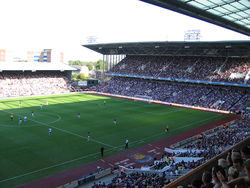
West Ham are currently based at the Boleyn Ground, commonly known as Upton Park, in Newham, metropolitan Essex, east London. The capacity of the Boleyn Ground is 35,303.[1] This has been West Ham's ground since 1904. Prior to this, in their previous incarnation of Thames Ironworks, they played at Hermit Road in Canning Town and briefly at Browning Road in East Ham, before moving to the Memorial Grounds in Plaistow in 1897. They retained the stadium during their transition to becoming West Ham United and were there for a further four seasons before moving to the Boleyn Ground in 1904.

Former chairman Eggert Magnússon made clear his ambition for West Ham United to move to the Olympic Stadium after the 2012 Olympics. However, the move to the Olympic Stadium was abandoned when it was revealed that the stadium would have a reduced capacity from the current Boleyn Ground, and would have to remain primarily an athletics venue.[47]
Former Club Chief Executive Scott Duxbury revealed in an interview with a West Ham fan website,[48] that there was planning permission to expand the East Stand to take capacity to over 40,000 although financial constraints of the current owners meant this would not happen for sometime. He said he would prefer to stay at Upton Park. Any progress on expansion or a move from Upton Park seems unlikely until a new owner is found and/or the 2012 Olympics are over.
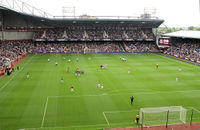
When current chairmen Gold and Sullivan assumed control of West Ham they also stated their ambition for West Ham United to move to the Olympic Stadium after the 2012 Olympics and felt it was a logical move for the Government as it was in the borough of Newham. But, in the month of February 2010, the British Olympic Minister stated that West Ham wouldn't get the stadium, and it would instead be used for track and field.[49] On 17 May 2010 West Ham and Newham council submitted a formal plan to the Olympic Park Leagacy Company for the use of the Olympic Stadium following the 2012 Olympic Games. The proposal was for a stadium with a capacity of 60,000 which would retain a competition athletics track. The proposal was welcomed by the chairman of UK athletics, Ed Warner, who said "I think it will feel great as a football stadium and I speak as a football fan as well the chairman of UK Athletics. I think you'd find West Ham would cover the track in the winter season so it wouldn't look like you had a track between you and the pitch".[50][51]
The Academy of Football
The club promotes the popular idea of West Ham being "The Academy of Football", with the moniker adorning the ground's new stadium façade. The comment predominantly refers to the club's youth development system which was established by manager Ted Fenton during the 1950s, that has seen a number of international players emerge through the ranks.[52] Most notably the club contributed three players to the World Cup winning England side of 1966 including club icon Bobby Moore, as well as Martin Peters and Geoff Hurst who between them scored all of England's goals in the eventual 4–2 victory. Other academy players that have gone on to play for England have included Trevor Brooking, Alvin Martin, Tony Cottee and Paul Ince.
Since the late 1990s Rio Ferdinand, Frank Lampard, Joe Cole, Michael Carrick and Glen Johnson begun their careers at the club and all are playing for one of the "Big Four" clubs. Most recently the likes of first team midfield regulars Mark Noble and Jack Collison and younger stars Freddie Sears, Junior Stanislas, James Tomkins, Josh Payne and Zavon Hines have emerged through the Academy. Frustratingly, for the fans and managers alike,[53] the club has struggled to retain many of these players due to (predominantly) financial[54] reasons. West Ham, during the 2007/08 season, had an average of 6.61 English players in the starting line up, higher than any other Premier League club,[55] which cemented their status as one of the few Premier League clubs left that were recognised to be bringing through young English talent and were recognised as having 'homegrown players'.
Much of the success of The Academy has been attributed to Tony Carr who has been West Ham youth coach since 1973.[56]
A sign of the success of the academy was shown in an England International Friendly against the Netherlands (finished 2–2) where no less than seven of the players on the field had some affiliation with the club, a large proportion from the academy itself.
Players
Current squad
- As of 7 September 2010[57]
Note: Flags indicate national team as has been defined under FIFA eligibility rules. Players may hold more than one non-FIFA nationality.
|
|
Out on loan
|
Jack Ling- Record Goal Scorer (247 goals in 206 games)
Reserve and youth squads
Retired numbers
Note: Flags indicate national team as has been defined under FIFA eligibility rules. Players may hold more than one non-FIFA nationality.
|
Club captains
| Dates | Name | Notes |
|---|---|---|
| 1895 | ||
| 1895–98 | Unknown | |
| c.1898–99 | ||
| 1899 | Following an accidental kick to the head, Bradshaw died shortly after on Christmas Day | |
| 1899–03 | Unknown | |
| c.1903–04 | ||
| 1904–07 | ||
| 1907–11 | ||
| 1911–15 | ||
| 1915–19 | None | No football was played during the First World War |
| 1919–21 | Unknown | |
| c.1921–22 | ||
| 1922–26 | ||
| 1926–27 | ||
| 1927–28 | Unknown | |
| 1928–29 | ||
| 1929–36 | Unknown | |
| c.1936–39 | ||
| 1939–45 | None | No football was played during the Second World War |
| 1945–47 | Remained captain after World War II | |
| 1947–51 | Following his retirement, he helped to clean the boots of younger players | |
| 1951–57 | Fell ill with tuberculosis after a game in 1957 and consequently had a lung removed | |
| 1957–60 | First captain not from the United Kingdom | |
| 1960–61 | ||
| 1961–74 | ||
| 1974–84 | ||
| 1984–90 | ||
| 1990–92 | ||
| 1992–93 | ||
| 1993–96 | ||
| 1996–97 | ||
| 1997–01 | ||
| 2001–03 | ||
| 2003 | ||
| 2003–05 | ||
| 2005–07 | ||
| 2007–09 | First captain from outside Europe | |
| 2009– |
West Ham dream team
In the 2003 book The Official West Ham United Dream Team, 500 fans were quizzed for who would be in their all time Hammers Eleven. The voting was restricted to players from the modern era.
| 1 | GK | Phil Parkes | |
| 2 | DF | Ray Stewart | |
| 3 | DF | Julian Dicks | |
| 4 | MF | Billy Bonds | |
| 5 | DF | Alvin Martin | |
| 6 | DF | Bobby Moore | |
| 7 | MF | Martin Peters | |
| 8 | MF | Trevor Brooking | |
| 9 | FW | Geoff Hurst | |
| 10 | FW | Paolo Di Canio | |
| 11 | MF | Alan Devonshire |
Hammer of the Year
The following is a list of the "Hammer of the Year award" won by West Ham United players.[58] Trevor Brooking is the only player for West Ham United to have been honoured with the title of 'Hammer of the Year' three times in a row (1976, 1977 and 1978). He also is the player who has won the award most times as he has won it on five occasions (1972, 1976, 1977, 1978 and 1984). Bobby Moore, Billy Bonds and Julian Dicks have won it four times each.
Bobby Moore has been runner-up four times, while Billy Bonds and Tony Cottee have both been runner-up three times.
Billy Bonds and Trevor Brooking's wins are notable in the amount of time between first and last "Hammer of the Year Award". Bonds has sixteen years separating his wins whilst Brooking has twelve.
|
|
Current staff
- As of 19th August 2010.[59]
CLUB STAFF/DIRECTORS
COACHING STAFF
|
||||||||||||||||||||||||||||||||||||||||||||||||||||||||||||||||||||||||||||||||||||||||||||||||||||||||||||||||||||||||||||||||||||||||||||||||||||||||||||||||||||||||||||||||||||||||||||||||||||||||||||||||||||||||||||||||||||||||||||||||||||||||||||||||||||||||||||||||||||||||||
